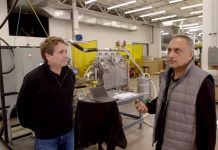One of the most common pieces of laboratory equipment today is the Bunsen burner. It is named after its inventor, Robert Bunsen, who suggested the design schematics of the burner to the mechanic who was building his laboratory, Peter Desaga. Although the Bunsen burner is named after Robert Bunsen, he is not actually credited with the actual invention of the first laboratory burner. That distinction goes to a gas engineer named R. W. Elsner and his patented burner in 1856.
Not much is known about Elsner, but another famous inventor, Michael Faraday, also improved the design of the laboratory burner before Bunsen and Desaga created the modern Bunsen burner. Here is a look at Faraday’s work.
1. The Faraday Cage
When someone or something is inside of a Faraday Cage, it is blocked from external static that exists in the surrounding environment. It reduces electromagnetic noise and that means everything from an amplifier to a clean room may utilize the technology of this cage. The exterior will distribute an electrical charge around the exterior of the cage and cancel out electrical radiation within the interior of the cage. Nothing electrical influences the interior of the cage whatsoever when fully enclosed, this invention is due to Faraday’s discoveries during his ice pail experiment.
2. Toy Balloons
Before Faraday began to work with rubber materials, the first balloons that were used were usually made from animal intestines. In 1824, Faraday invented the first balloons so that he could work with helium in an effective way. Working at the Royal Institution in London, the novelty of these balloons wasn’t lost on people and they soon made their way into homes and have been loved by kids ever since.
3. Electric Motors
Motors typically worked because of manpower or horse power in the early 1800’s. There were also experiments that were starting with electricity at the time, but it was primarily seen as a gimmick or a way to show off something neat about science more than anything practical. Faraday worked with motors and created the mechanism that would convert electrical energy into mechanical energy, inadvertently used in a number of applications.
4. Electromagnetic Fields
With Faraday’s research into magnetic fields around conductors, Faraday established the basis of electromagnetic fields that changed the world’s knowledge of physics. His law of induction and the Faraday Effect became staples of scientific knowledge, but it didn’t just stop there for him. Faraday discovered benzene and is responsible for popularizing several scientific terms, such as cathodes, ions, and electrodes.
5. Levitation
Before Faraday’s work, it was generally accepted that magnetic fields existed. What wasn’t realized was that many materials had a repulsion for magnetic fields, which is a term he called diamagnetism. Using this principle, things like levitation become possible because of the force being exhibited by the magnetic field and the repulsion of the material responding in some way to it.
Strong proponent of individual liberty and free speech. My goal is to present information that expands our awareness of crucial issues and exposes the manufactured illusion of freedom that we are sold in America. Question everything because nothing is what it seems.



















